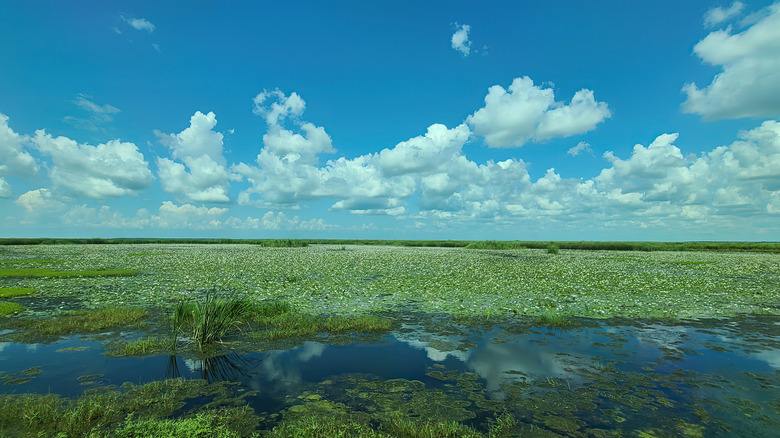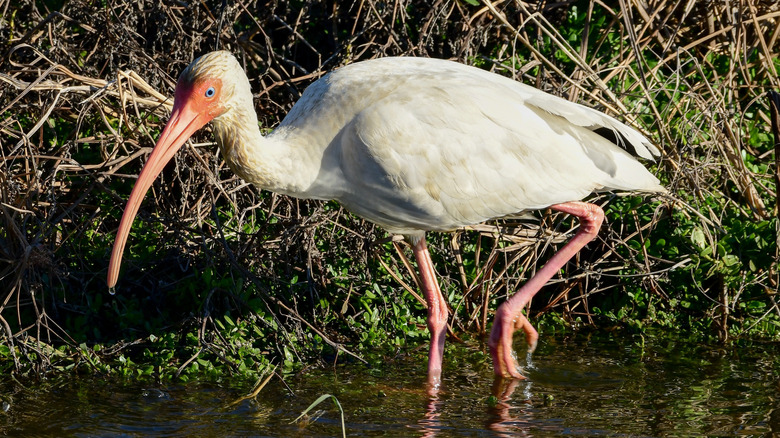The 'Alligator Capital Of Texas' Is A Lakefront City Brimming With Wildlife, Rich History, And Incredible Fishing
As the second-largest state in the U.S., Texas is vast, comprising 10 different biomes or ecoregions, from piney woods and marshes in the east to rolling plains and highlands in the north. This has led to an even more diverse range of natural habitats, harboring 540 bird species, 142 mammals, and various amphibians and reptiles like the Texas blind salamander, the rat snake, the skink lizard, and the sea turtle. There are thousands of tigers in Texas, too, though these are in captivity — as was memorably documented in Netflix's wild series "Tiger King" — and even one of America's most shark-infested beaches. And along the Gulf Coast, you'll find large populations of an animal usually associated with Louisiana or Florida: the American alligator, the only crocodilian native to Texas.
Set within Trinity Bay, just east of Houston, sits the small city of Anahuac. Since 1989, Anahuac has been known as the state's "Alligator Capital." It was once home to the nomadic Karankawa tribespeople, who viewed alligators much as tribes on the Great Plains viewed bison. The Karankawa hunted alligators for food, while accounts from Spanish sailors mention they used rendered alligator grease as a ward against insects. Alligators are now a protected game species in Texas, but they're still central to life in Anahuac, with many visitors coming to explore the 30,000-acre Anahuac National Wildlife Refuge and its resident gators.
While in Anahuac, you can also visit nearby ranches and vineyards, or go fishing for trout, redfish, and flounder in East Galveston Bay. You can fish in Lake Anahuac, too, which permits nonmotorized vehicles like canoes and kayaks. Thousands visit the city for the Texas Gatorfest in fall, a celebration of the region's spirit animal, while history buffs can travel back in time at Fort Anahuac Park and at the Chambers County Historical Museum.
Wildlife and fishing in Anahuac's lush natural landscapes
The Anahuac National Wildlife Refuge, now formally known as the Jocelyn Nungaray National Wildlife Refuge (in honor of a Texan girl who was murdered in 2024), is a good place to kick off your travels in Anahuac. Initially established to support migrating waterfowl, the refuge is now home to a panoply of species throughout the year.
Keep an eye out for frogs, bees, nesting birds, and otters in spring; snakes, blooming wildflowers, dragonflies, and storks in summer; butterflies, turtles, and rabbits in fall; and hawks, eagles, and flocks of waterfowl escaping colder climes in winter. Alligators are present in all seasons, though less so in winter. You can navigate the refuge on foot or by off-road vehicle; there are also fishing piers and boating ramps in the area.
Port Aransas may be the fishing capital of Texas, but Anahuac would be in the running for second place, with both fresh- and saltwater-fishing options on the city's doorstep. Fishing and crabbing are permitted (with a Texas fishing license) within the refuge, where you'll also find bass, crappie, and species of catfish. In Lake Anahuac, located on the north side of town, surfcasting and baitcasting are popular among the resident fishermen. While a license is typically required here, the first Saturday of June each year is "Free Fishing Day," when anyone can throw their line into Texas' fishing waters.
Reliving the storied history of Anahuac
It's not just the unorthodox use of gator grease that makes Anahuac's history compelling. On a bluff overlooking the Trinity River in 1830, Fort Anahuac was established as the headquarters of a Mexican Army division. The colonel overseeing operations at the fort, Juan Davis Bradburn, was tasked with policing the borders between Texas (then part of Mexico) and the surrounding states, which aggrieved colonists seeking control of the area.
This eventually led to a bloody uprising, which helped kick-start the Texas Revolution of 1835-36. There are no remnants of the old wooden fortification today, but you can visit the site of the conflict, which is today used as a fishing and leisure spot (there are also plans to build a museum here in the coming years).
The Texas Gatorfest, which has been running for more than 35 years, is one of the best fall festivals in the state — and is also a window into Anahuac's history. The festival features market vendors, vintage car shows, a carnival, a 5K run, a barbecue cook-off, live music, and an alligator round-up, where licensed gator hunters showcase their kills and compete for prizes. These are awarded to the longest alligator each hour (and each day), and the longest alligator from Chambers County.


